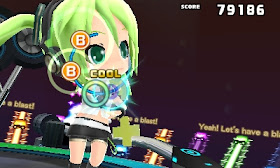Pages
▼
Wednesday, February 8, 2017
Hatsune Miku: Project Mirai DX (3DS)
Hatsune Miku: Project Mirai DX is a rhythm game and the first Miku game to be released in the West for 3DS. The aesthetics of the game differs from past games in that they are in chibi style, with heads that are proportionally too big for their bodies. This may put you off and to be honest, it looks a bit unnatural but it can be quite cute at times. The rhythm gameplay is slightly changed from the Project DIVA series. While you still use the four face buttons and tap it in time with the music and lyrics, it doesn't fly in from all over the screen.
The button prompts now follow a line which makes them much easier to follow and anticipate which notes are coming up. You will also occasionally use the directional buttons as well as holding buttons down. There is another control scheme which makes use of the touchscreen. Up to three colored sections will show on the bottom screen and you can tap the screen in time with the music using the stylus. It actually works much better than you'd expect and difficulty is lower than the button-control scheme as it doesn't have as many sections where there are some insanely frequent button sequences.
While the button prompts are showing on screen and you're focusing on it, the background will be playing a video. You probably won't be paying as much attention to the background video but there is a Theatre Mode to enjoy these videos in their full glory and it is worthwhile to do so. There are a lot of details put into these videos and even if you don't understand the lyrics, you can tell what the song is about just from looking at the visuals. The 3D effect also works really well here.
The gameplay is very immersive and addictive. It plays on the mentality of playing a track one more time to obtain higher and higher scores. Yes, each song will have various difficulties, the easiest one uses only two face buttons while the harder ones will use all four face buttons. Unfortunately, if you're used to the PlayStation controller, then you will definitely get confused over the face buttons since the blue colored "X" is the top button instead of the bottom; likewise, the green colored "Y" is on the left not the top. This makes harder difficulties confusing initially and will definitely take a short while to readjust you muscle memory.
Note that you can change the color of the button prompts through an option in the game, and the color coded buttons are the same as the New 3DS's physical buttons, so this helps in alleviating the confusion. Assuming you've only played the English translated Miku games so far, then there are many more new songs that wasn't in Project DIVA F or F 2nd, which is a welcome change and includes some really nice tracks such as "Hello/How are you?", "Cendrillon" and "glow", as well as classic tracks like "World is Mine" and "Romeo and Cinderella". There are a total of 48 songs in the game which presents huge value for money and heaps of variety. You're bound to find something that you like.
All the songs are in Japanese and the menus are translated into English. There are no English translated lyrics either. In case you didn't know already, the songs are sung by Vocaloids, which are digital synthesizers. Apart from the core rhythm game, there are some side activities that you can do. In the beginning of the game, you can choose a partner, being Miku, Kaito, Rin, Len, Luka and Meiko. You then pick a home. From time to time, Gumi also shows up as a guest. You can change these at any time.
Playing the rhythm game will earn you points and these are used to buy costumes, furniture and items/food. You can then use these to decorate your home and give food to your partner, which shows some amusing scenes. Although these things will only entertain you for so long. There are two minigames, the first is Reversi, the board game where you place stones in order to covert them into your color. Don't dismiss this as it is a complex strategy game that's easy to learn, and the AI is actually not too bad at it.
The other minigame is Puyo Puyo 39, which is a type of Tetris-like game that you play against a computer or another player (only if they also have a copy of the game though). You will compete against different characters successively to gain a high score. Other inclusions include AR. The game includes 19 double sided AR cards to play certain songs but the execution isn't that great (refer below for a scan of the cards). There's a tune creator and achievements which are called stamps within the game. Overall, Project Mirai DX is a fantastic game and very addictive. It has a decent number and variety of songs to play and the rhythm mechanics are excellent. This is definitely a game to get if you're a fan of Vocaloids.
---------------------------------------------------
For other game reviews, have a look at this page.
---------------------------------------------------
And here's a quick scan of the AR cards provided with the game.












